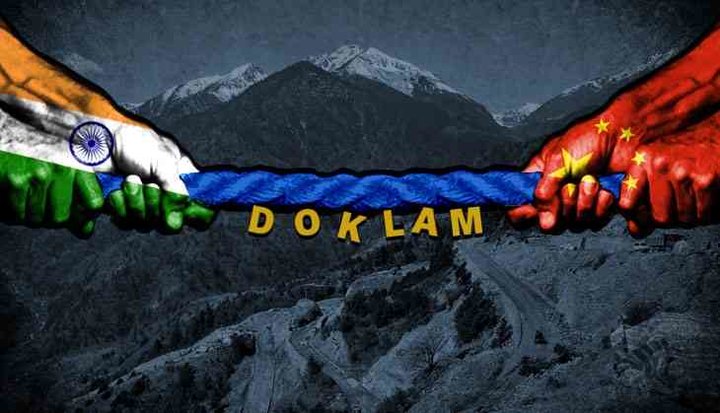
(TibetanReview.net, Aug11, 2017) – With diplomatic efforts to end the seven-week military standoff at Doklam having hit a roadblock, underlined by China’s insistence that India unilaterally withdraw its troops from the remote plateau site which is also claimed by Bhutan, both the sides have been reported to be veering towards preparing for the likelihood of an armed conflict. However, no major ort unusual mobilization is reported to be taking place towards the Line of Actual Control yet.
China’s official party mouthpiece People’s Daily was reported to have tweeted that the Indian Army had asked villagers living in nearby Nathang to immediately vacate their houses. The Sikkim village is located just 35 km from Doklam. However, the timesofindia.com Aug 10 cited the Indian Army as denying it had ordered evacuation of some villages (namely Kuppup, Nathang and Zuluk) near the Sikkim-Bhutan-Tibet tri-junction.
The report also cited Indian government sources as saying there had been “some build-up” in terms of additional troops and tanks as well as artillery and air defence units in the Tibet Military District by the Chinese People’s Liberation Army (PLA), but that there was “no major or unusual mobilization” towards the Line of Actual Control as yet to send alarm bells clanging in the Indian security establishment.
The report further quoted the source as saying, “Any major PLA mobilization towards our border will be detected since it will take around a week. Our well-acclimatized troops, backed by artillery, rockets and other heavy-calibre weapons, are currently deployed in the ‘no war, no peace’ mode. They are ready to respond quickly if required.”
According to zeenews.india.com Aug 10, China had stepped up its troop presence at a distance of around one kilometre from Doklam plateau, north of India’s Doka La post in Sikkim.
“This is where the Chinese have pitched around 80 tents for the People’s Liberation Army (PLA) soldiers,” with the number of troops estimated to be less than 800, reported indianexpress.com Aug 10. The report said this was in addition to the 300 Chinese soldiers deployed at the standoff site, facing at least 350 Indian soldiers who had pitched tents in the area.
The timesofindia.com report said the Indian Army continued to maintain high operational readiness along the 4,057-km Line of Actual Control stretching from Ladakh to Arunachal Pradesh, having initiated its annual “operational alert” much before the usual Sep-Oct timeframe. “Our troops are better placed and entrenched in the Sikkim tri-junction area. It makes more military sense for the PLA to create mischief in some other sector if it actually comes to that,” it quoted another source as saying.
Nevertheless, the report said, India has been steadily but discreetly moving the bulk of its soldiers under the 17 (Gangtok) and 27 (Kalimpong) Mountain Divisions (each having over 10,000 troops) of the Sukna-based 33 Corps to their “operational alert areas” to cater for any contingency.
* * *
Meanwhile, China has been continuing its war of words suggestive of rising urgency of the situation. On Aug 9, its official China Daily newspaper warned that ‘the countdown to a clash between the two forces has begun’. In an editorial titled ‘New Delhi should come to its senses while it has time’, the publication said the window to peacefully resolve the standoff in Doklam was closing. “The countdown to a clash between the two forces has begun, and the clock is ticking away the time to what seems to be an inevitable conclusion,” it said.
In diplomatic talks, China had not responded to India’s suggestion that it move its troops back 250 meters (820 ft) in order for it to withdraw in return, reported Reuters Aug 8, citing source with close ties to Prime Minister Narendra Modi’s government.
It was stated to be a low-key diplomatic maneuvers that took place outside the public eye. The Chinese side was reported to have countered with an offer to move back 100 meters (328 ft), so long as they received clearance from top government officials. However, this was denied by China’s Foreign Ministry, according to the official Chinadaily.com.cn Aug 11.
The report continued that there had been no comeback since then, except for China’s mounting warnings of an escalation in the region. “It is a logjam, there is no movement at all now,” the report quoted a second source with knowledge of the talks as saying.
* * *
Meanwhile, the Government of Bhutan on Aug 10 refuted the Chinese foreign ministry’s claims about it having told Beijing that the trilateral border stand-off area in Doklam in the Sikkim sector was not its territory. The claims were made by top Chinese diplomat Ms Wang Wenli. Wang, who is also the deputy director general of the Department of Boundary and Ocean Affairs in China’s foreign ministry, had claimed to a visiting Indian media delegation on Aug 9 that Bhutan had conveyed to Beijing through diplomatic channels that the area of the standoff was not its territory.
“Our position on the border issue of Doklam is very clear. Please refer to our statement which has been published on the web site of Bhutan’s foreign ministry on June 29, 2017,” official sources in the Bhutanese Government were reported to have told the ANI news agency over phone.
What is more, the Bhutanese foreign ministry has emphasized that “the construction of the road inside Bhutanese territory is a direct violation of the 1988 and 1998 agreements between Bhutan and China and affects the process of demarcating the boundary between these two countries.”
It was the road construction which led to the present standoff.


